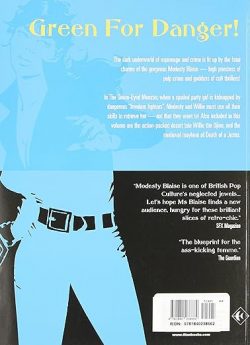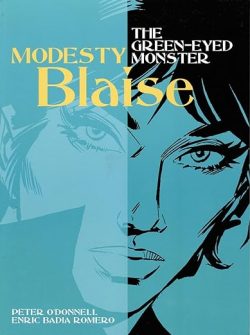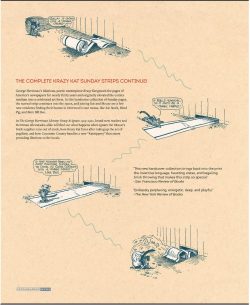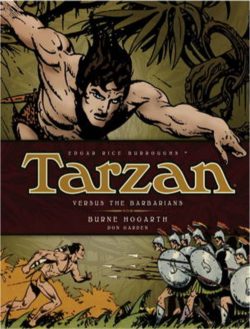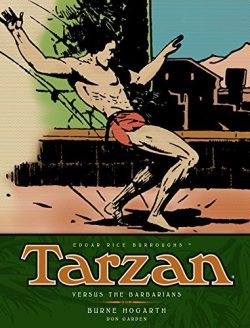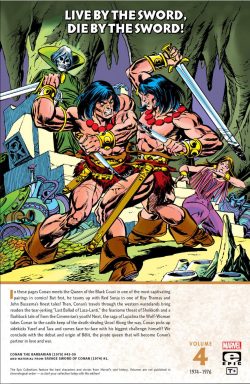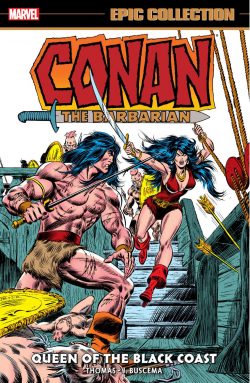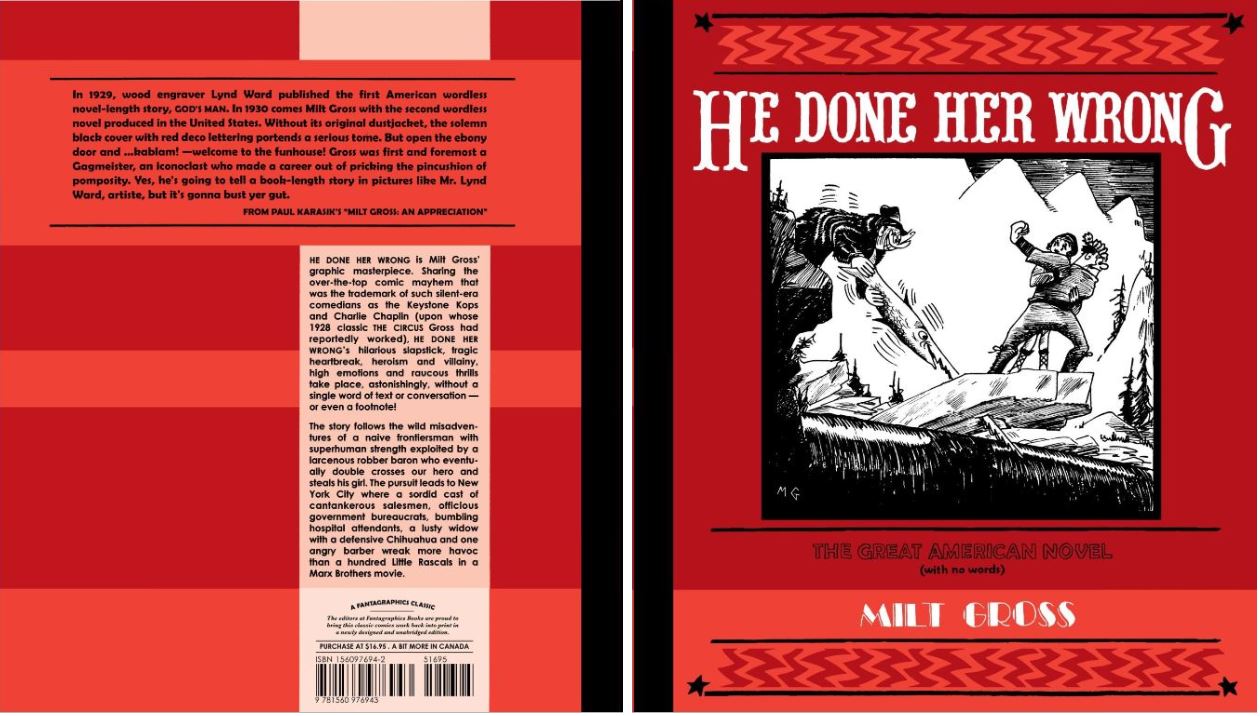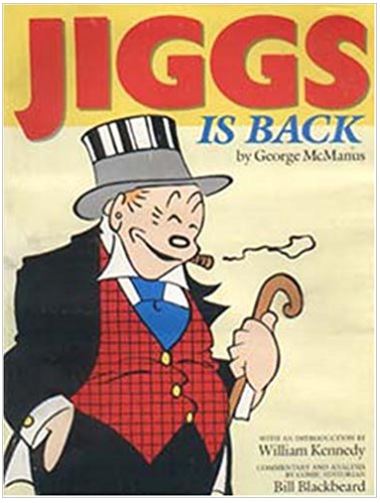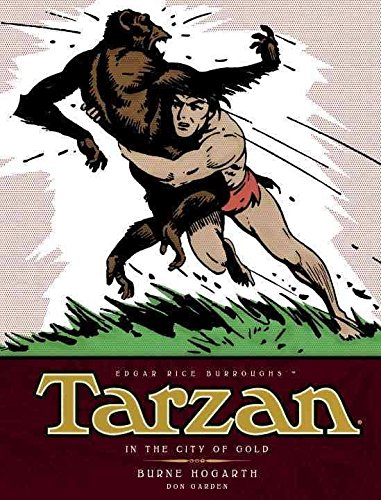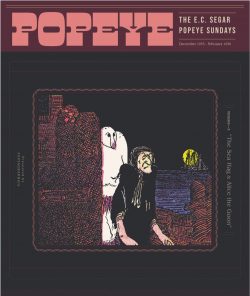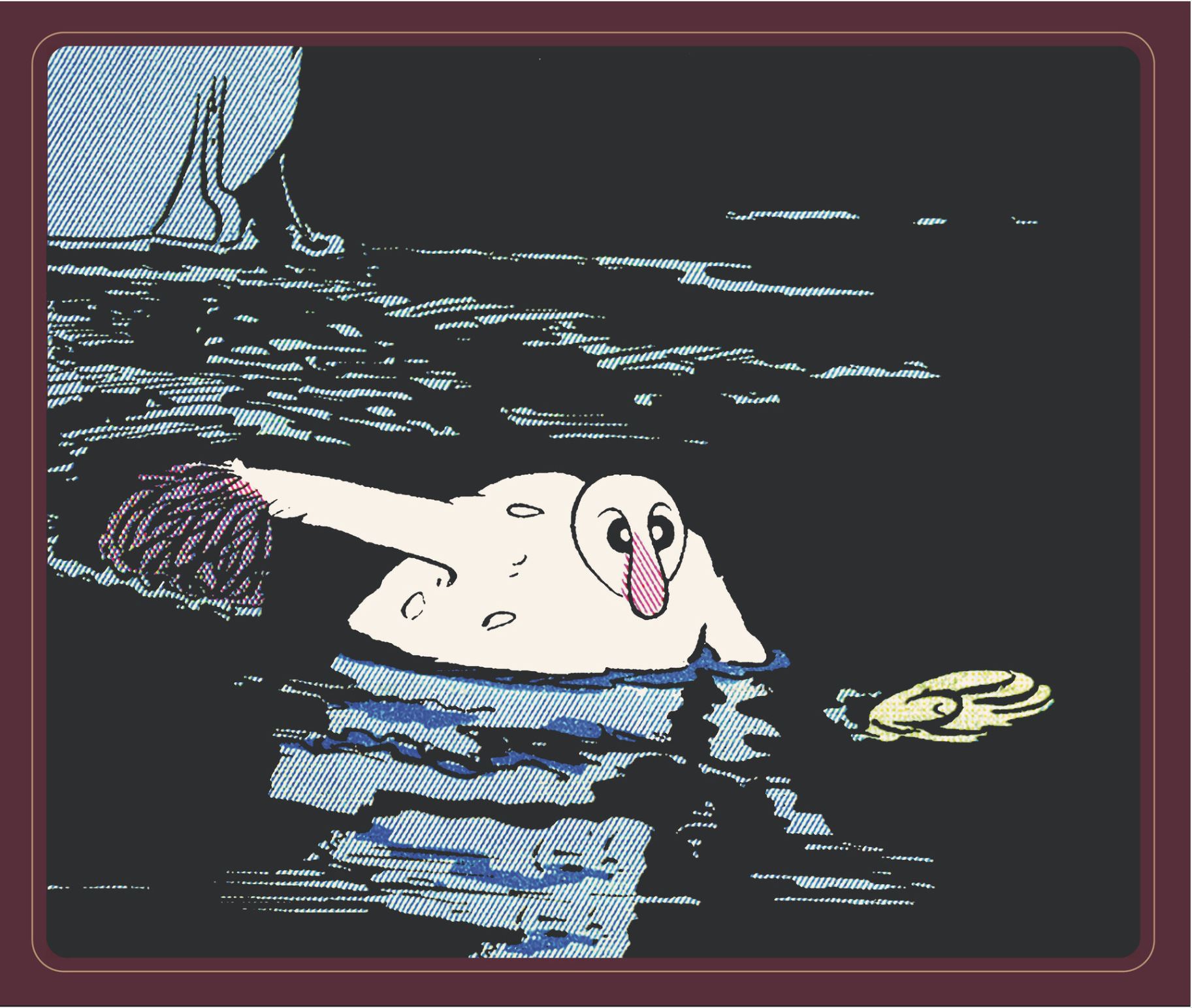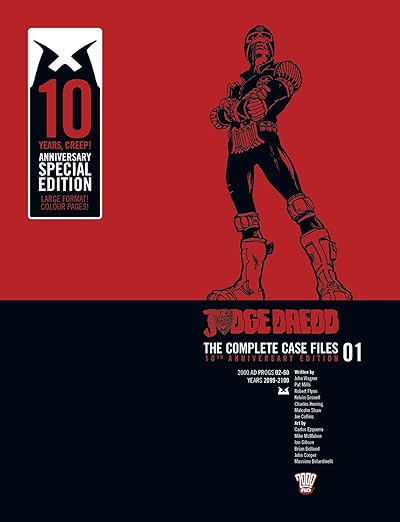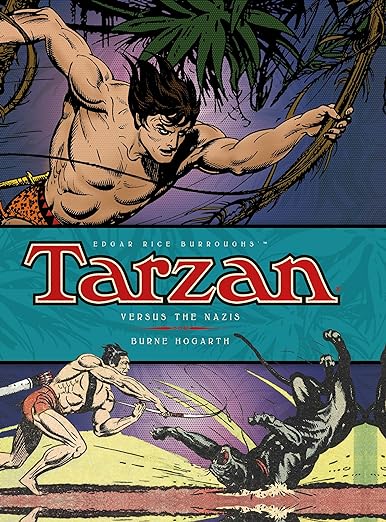
By Burne Hogarth with Don Garden & Rubén Moreira (Titan Books)
ISBN: 978-1-78116-319-1 (Album HB)
The 1930 and 1940s was an era of astounding pictorial periodical adventure. In the years before television, newspaper strips (and later comic books) were the only visually-based home entertainment for millions of citizens young and old and consequently shaped the culture of many nations. Relatively few strips attained near-universal approval and acclaim. Flash Gordon, Terry and the Pirates and Prince Valiant were in that rarefied pantheon but arguably the most famous was Tarzan.
The dramatic adventure serial as we know it started on January 7th 1929 with Buck Rogers and Tarzan debuting that day. Both were adaptations of pre-existing prose properties and their influence changed the shape of the medium forever. An explosion of similar fare followed, launched with astounding rapidity and success. Not just strips but actual genres were created in that decade, still impacting on today’s comic-books and, in truth, all our popular fiction forms.
In terms of sheer quality, the adaptations of Edgar Rice Burroughs’ immensely successful novels starring jungle-bred John Clayton, Lord Greystoke by Hal Foster were unsurpassed, and the strip soon became a firm favourite of the masses, supplementing movies, books, a radio show and ubiquitous advertising appearances. As detailed in previous volumes of this oversized (330 x 254 mm), full-colour hardback series, Foster initially quit at the end of a 10-week adaptation of first novel Tarzan of the Apes and was replaced by Rex Maxon. At the insistent urging of Edgar Rice Burroughs, Foster returned when the black-&-white daily expanded to include a lush, full colour Sunday page featuring original adventures.
Maxon was left to capably handle the weekday book adaptations, and Foster crafted the epic and lavish Sunday page until 1936 (233 consecutive weeks). He then left again, for good: moving to King Features Syndicate and his own landmark weekend masterpiece Prince Valiant in the Days of King Arthur which debuted in February 1937. Once the four-month backlog of material he had built up was gone, Foster was succeeded by a precociously brilliant 25-year-old artist named Burne Hogarth: a graphic visionary whose astounding anatomical acumen, cinematic design flair and compelling page composition revolutionised the entire field of action/adventure narrative illustration. The galvanic modern dynamism of the idealised human figure in today’s comicbooks can be directly attributed to Hogarth’s pioneering drawing and, in later years, educational efforts. Burroughs cannily used the increasingly popular comic strip to cross-market his own prose efforts with great effect…
This third titanic tome begins with the prolifically illustrated ‘Hogarth on Burroughs’: George T. McWhorter’s interview with the master draughtsman from 1982’s Edgar Rice Burroughs Quarterly volume 1 #1, after which the timeless adventure resumes. At this time Hogarth had assumed writing the strip too, with veteran collaborator Don Garden leaving to pursue other, more patriotic pursuits.
Running from 30th October 1943 – March 12th 1944 (episodes #660-679), ‘Tarzan Against Kandullah and the Nazis’ is an explosive procession of coiled-spring action and crushing suspense as the Ape-Man, incessantly crisscrossing fabled, unexplored Africa returns to the lands of the Boers. Here he discovers his old friends infiltrated by insidious Nazi deserters. The human monsters have seen the tide of history turn against them and instead of fighting on or surrendering are attempting to secure this desolate enclave from which they can rebuild a Fourth Reich to attack democracy again at some future date…
Their plan is to divide and conquer: fomenting strife between the indigenous Mogalla tribe and the isolationist Afrikaaners. After narrowly averting one blood-stained crisis, Tarzan swears to deliver a military packet for a dying Allied airman, undertaking a staggering trek across the hostile lands before anonymously completing his mission and heading back into the veldt. His travels next bring him into contention with a baroque and murderous slave-master in ‘Tarzan Against Don Macabre’ (#680-699, running from 19th March to 30th July). After rescuing beautiful captive Thaissa from his decadent clutches, the all-conquering Ape-Man decimates the Don’s menagerie of savage beasts – everything from a ravening bull to a giant octopus – and leads a slave revolt deep within his island citadel…
Once back on the mainland there was an extended return engagement for modern history’s most popular bad guys in ‘Tarzan Against the Nazis’ (#700-731, August 6th 1944-March 11th 1945). This clash began innocuously enough with the Jungle Lord saving albino ape Bulak from his own dark-pelted tribe, before being distracted by sadistic Arabian hunter Korojak. The vile stalker was trapping hundreds of animals for his master Emin-Nagra – and secretly mistreating his prizes for his own sick amusement – until Tarzan taught him the error of his ways. Sadly, it was not a lesson which stuck and before long both Bulak and Tarzan became part of the booty being transported to golden-domed city Bakhir…
While the Ape-Man chafed in captivity as part of Emin-Nagra’s Circus, agents of Germany and Japan were negotiating for the oil under the cruel potentate’s pocket kingdom and quietly confident of a favourable deal, due to their column of storm troopers. However, when Tarzan faced a tidal wave of starved jungle beasts in the Circus, he turned them into his personal army to bring down the despot. Then he turned his merciless attention to the Nazis and their nearby new oil wells…
With the real-world war winding down, escapist fantasy became a larger part of the Sunday strip environment. ‘Tarzan Against the Gorm-Bongara Monster’ (#732-748, 18th March to July 8th) saw the nomadic Ape-Man encounter a lost tribe of pygmies in a primordial valley, battling against them before becoming their champion against a marauding, voracious dinosaur. His inevitable victory led directly into ‘Tarzan and The Tartars Part One’ (#749-768, July 15th – November 25th) wherein landless Prince Kurdu begged the Ape-Man’s assistance in overthrowing a usurper and saving his oppressed kingdom. The turbulent alliance offered privation, hardship, a quest for mystic relics and – for one of the heroes at least – the promise of true love. This romantic epic is divided into separate chapters because from December 2nd 1945 onwards, Hogarth was replaced as illustrator by Ruben Moreira, who finished the tale from his predecessor’s scripts.
‘Tarzan and The Tartars Part Two’ (pages #769-778) concluded with the February 3rd 1946) instalment, after which Don Garden returned to provide fresh material for Moreira. You won’t find that here…
Hogarth was in dispute with the feature’s owners and had moved to the Robert Hall Syndicate for whom he produced seminal adventure classic Drago and thereafter United Features where he created comedy strip Miracle Jones. During the time away from Tarzan, Hogarth – with Silas Rhodes – also opened the Cartoonists and Illustrators School which later evolved into the School of Visual Arts.
After his two-year hiatus, Hogarth bombastically returned to the Lord of the Jungle in 1947, midway through an ongoing story. For the sake of convenience, Garden & Moreira’s ‘Tarzan on the Island of Ka-Gor Part One’ (#840-856, April 13th-3rd August 1947) is included here, setting the scene as sassy Texan heiress Dallas Doyle journeys to the home of Tarzan and his mate Jane, determined to recruit the famed adventurer in the search for her long-missing father. It takes a lot of persuading, but eventually Tarzan capitulates, due in no small part to the urgings of native mystic Maker of Ghosts…
Following an old map of a diamond mine, the expedition proceeds slowly until sneak thief Dirk Mungo and a devious riverboat skipper steal it and frame Tarzan. Jailed by a corrupt police official, the Ape-Man abandons the niceties of civilisation and breaks out, following the villains with Dallas and golden lion Jad-Bal-Ja rushing to keep up. The trail takes them through all manner of incredible horror before culminating in an aeroplane dogfight. Shot down but surviving, the pursuers doggedly press on, until captured by pygmies who trade them to decadent priests…
‘Tarzan on the Island of Ka-Gor Part Two’ (#857-861, August 10th to 7th September 1947) sees Hogarth’s spectacular re-emergence, illustrating Garden’s script as the lost Doyle patriarch is finally found and rescued, just as the entire lost world he ruled succumbs to volcanic destruction. Hogarth then took sole control again for the concluding instalments.
‘Tarzan on the Island of Ka-Gor Part Three’ (#862-874, 14th September-7th December 1947) swiftly wrapped up the saga with the hero saving his companions but almost losing his own life in the process.
Wounded unto death, Tarzan is lost and expiring with rumours of his passing inciting various villains of the jungle lands to begin their raids and depredations again. However, saved by the tender ministrations of Manu the monkey and elephantine comrade Tantor, Tarzan soon storms back to restore his fair if heavy-handed peace…
To Be Continued…
These tales are full of astounding, unremitting, unceasing action with Hogarth and the other contributors spinning page after page of blockbuster Technicolor action over months of non-stop wonder and exoticism. Plot was never as important as engendering a wild rush of rapt and rousing visceral responses, and every Sunday the strip delivered that in spades.
Edgar Rice Burroughs was a master of populist writing and always his prose crackled with energy and imagination. Hogarth was an inspired intellectual and, as well as gradually instilling his pages with ferocious, unceasing action, layered panels with subtle symbolism. Heroes looked noble, villains suitably vile and animals powerful and beautiful. Even vegetation, rocks and clouds looked spiky, edgy and liable to attack at a moment’s notice…
These vivid visual masterworks are all coiled-spring tension or vital, violently expressively explosive motion: stretching, running, jumping, fighting in a surging rush of power and glory. It’s a dream come true that these majestic exploits are back in print for ours and future generations of dedicated fantasists to explore and enjoy.
Tarzan ® and Edgar Rice Burroughs ™ & © Edgar Rice Burroughs, Inc. All Rights Reserved. All images Edgar Rice Burroughs, 2015. All text copyright Edgar Rice Burroughs, Inc 2015.

